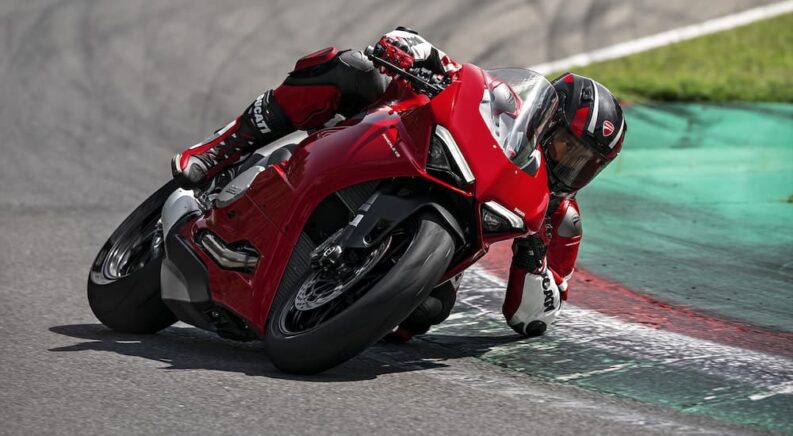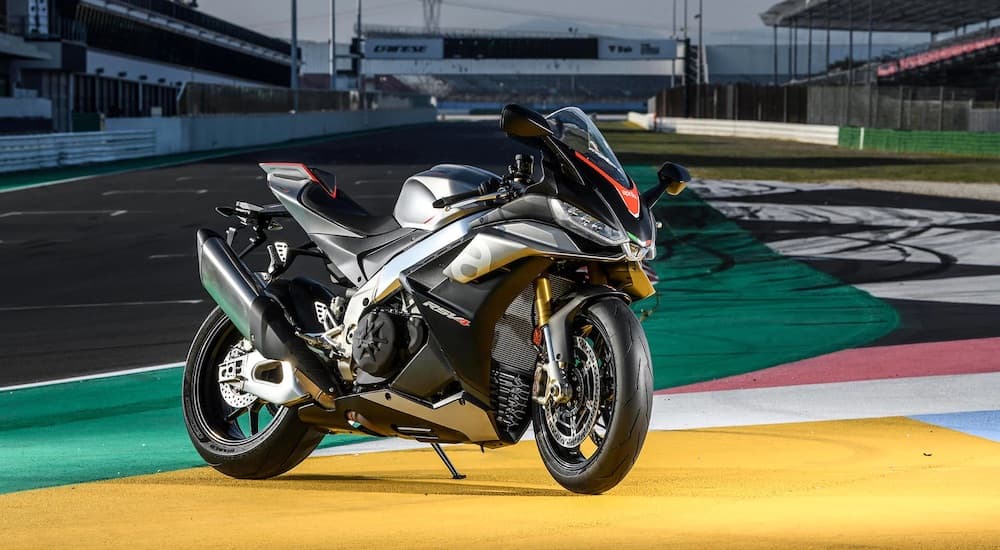From Sunday rides and long-distance touring to off-roading and impromptu stoplight-to-stoplight drag races, there are plenty of ways to keep yourself entertained in the saddle of a motorcycle. But what about those days when a ride isn’t in the cards? When rain, cold and finicky bikes get in the way of your asphalt ambitions, MotoGP is here to help, giving riders an outlet that allows them to witness some of the world’s best motorcycle racing from the comfort of their couch.
For the uninitiated, MotoGP is basically Formula One for the two-wheeled world, bringing the most talented riders, engineers, and racing teams together to deliver a high-octane racing experience complete with blazing speed, knee-scraping turns, and plenty of drama. Read on as we explore the history of MotoGP, see how motorcycle racing has evolved over the years, and take a look at some of the sport’s most famous tracks.
The Early Days of Motorcycle Racing
Motorcycle racing can trace its roots to the late 1800s, with the first recorded race taking place in 1894 in France. Organized by the Parisian newspaper Le Petit Journal, the race saw a group of motorcyclists meet on a local beach before racing from one town to the next. This race is often overshadowed in motorsports history by another event that took place in the same year: the Paris-Rouen race, which is widely considered to be the world’s first organized automobile race. The Paris-Rouen race was also organized by Le Petit Journal, proving that motorcycle and automobile racing have been closely linked since the two sports’ earliest days.
Motorcycle racing soon became a popular sport across the continent, with races popping up from the British Isles to Holland, Germany, and Switzerland. The Isle of Man TT (Tourist Trophy) is widely considered to be one of the sport’s oldest and longest-running races, taking place nearly every year since 1907. Motorcycle racing would continue to gain steam through the first half of the 1900s, although the advent of World War II saw all competitions put on pause as riders traded in their racing helmets for military-issue lids and marched off (or rode off) to the battlefield.
Motorcycle racing coalesced into a more formal endeavor in 1949 with the founding of the Road Racing World Championship Grand Prix by the Fédération Internationale de Motocyclisme (FIM). The first season included six races held all across Europe, culminating in the Nations Grand Prix at Monza in Italy. The competition included categories for a wide variety of engine sizes, including 500cc, 350cc, 250cc, and 125cc, and even sidecar entries. These days, MotoGP is divided into three main classes: MotoGP (1000cc), Moto2 (765cc), and Moto3 (250cc).
British manufacturers had a strong showing in early Grand Prix events, dominating many races in the 1950s and capturing three titles thanks in part to rider Geoff Duke. Duke would play a big role in overhauling the sport’s dress code, making waves with his tight-fitting, one-piece leather racing suit in place of the baggy affair favored by many other riders. German and Italian teams would give the Brits a run for their money through much of the 1950s, but it was a new challenger from the East that really revolutionized motorcycle racing.
When Honda rolled into the Isle of Man TT in 1959, few gave the Japanese team much thought. The team had a modest showing for its first outing but would return in force in the following years, dominating the 125cc class and earning its first world title in 1961 with the help of Australian rider Tom Phillis. This would begin a decade of dominance for Honda, which consistently finished in the top spot in nearly every class for much of the 1960s. Japanese motorcycle manufacturers Yamaha and Suzuki would enter the fray soon after, shifting the balance of power from European brands to their Japanese competitors.
An Ever-Evolving Sport
The sport would continue to evolve in subsequent years thanks to a raft of new automotive technology that saw Grand Prix bikes graced with two-stroke engines, disc brakes, aerodynamic fairings, and more. As the bikes became more powerful and the sport faster, a new challenger emerged. Superbike racing hit the scene in the 1980s and 1990s, drawing many fans away from the Grand Prix circuit in favor of the new series, which saw riders racing on production-based models. Modern MotoGP was the result of new rules and regulations designed to bring fans back into the fold, and the introduction of four-stroke engines in 2002 is widely credited with reviving the sport.
Fans are always going to flock to the most exciting league in any sport, and the new MotoGP engines made the bikes more powerful than ever, reigniting interest from spectators and advertisers alike. Recent innovations include the addition of winglets––small, aerodynamic features that improve stability at high speeds––as well as traction control, quick shift, and anti-wheelie systems. Carbon fiber has also had a major impact on the sport, with the light, strong material becoming the go-to choice for fairings and other important components.
Today, the world of MotoGP is overseen by Dorna Sports––which bought the broadcast rights to the sport in 1992––though the FIM remains the sport’s governing body. In truth, it’s something of a group effort with the International Road Racing Teams Association (IRTA), Motorcycle Sport Manufacturers Association (MSMA), Dorna, and the FIM all voting on new rules and regulations.
Top Motorcycle Tracks
TT Circuit Assen
Location: The Netherlands
First Grand Prix: 1949
If you’re looking for the most storied track in all of MotoGP, the conversation starts and ends with TT Circuit Assen. Commonly referred to as “The Cathedral” of motorcycle racing, the Dutch track is also the longest-serving course in the sport’s history, having hosted Grand Prix championship racing events every year since the series began in 1949. In fact, Assen has hosted more top-tier motorcycle racing events than any other venue in the world.
Originally laid out as a 17.7-mile track, TT Circuit Assen was once a true road course that weaved between local villages but is now a shadow of its former self at just 2.8 miles. That type of shrinkage doesn’t seem to matter to Dutch motorcycle racing fans, who flock to the course in droves each year to witness the world’s best riders take on the challenge. The course’s most famous feature is a highly technical chicane found just before the finish line, which requires racers to maintain their composure and stay on top of their game right up until the last turn.
Isle of Man TT
Location: United Kingdom
First Grand Prix: 1949
Located in the Irish Sea between Great Britain and Ireland, the Isle of Man has long held a spot in the hearts and minds of motorcycle racing fans the world over. The 1907 Isle of Man TT was one of the sport’s first large-scale races, with competitors from across the region flocking to the 221-square-mile island for what was then called the International Auto-Cycle Tourist Trophy. Originally run on a 15-mile course, organizers would shift to a mammoth 37-mile course in 1911. The course is particularly notable for its sheer elevation changes, with riders racing from sea level to 1,300 feet.
The Isle of Man TT became an official Grand Prix event in 1949, hosting the British round of the World Motorcycling Championship for nearly three decades. While the course has failed to appear on the MotoGP calendar since 1976 because of safety concerns, it remains one of the most storied circuits in the sport’s history. Unfortunately, it is also one of the deadliest. Over 250 riders have died on the Isle of Man TT since 1907, leading Sports Illustrated to dub it “sports’ most dangerous event.”
Brno Circuit
Location: Czech Republic
First Grand Prix: 1965
Those seeking a massive, festival-like atmosphere that also happens to include a top-flight motorcycle racing event need to look no further than the Czech Republic’s Brno Circuit. Constructed in a natural bowl outside the second-largest city in the Czech Republic, Brno Circuit is the home of the Czech Republic Motorcycle Grand Prix, which regularly attracts as many as 250,000 spectators to the track during the three-day event.
Like many of the tracks listed here, Brno Circuit was once much longer, spanning 18 miles prior to WWII but losing ground in the following decades to reach its current length of 3.3 miles. Burno has long been a staple on the MotoGP calendar, hosting Grand Prix events since 1965 and trailing only Assen in terms of all-time events. That streak came to an end in 2021 when track organizers opted out of the event due to financial constraints brought on by the pandemic, but it’s hard to think that this jewel in the MotoGP crown is gone for good.
An Epic Event
If you’re looking for a way to live out your motorcycle racing dreams without leaving the house––or risking every bone in your body––MotoGP awaits. The sport might lack the glitz, glamor, and Netflix coverage of Formula One, but it’s certainly on the rise. MotoGP currently has 40 million fans across various social media platforms, which is especially impressive given that number only hit the 30 million mark one year earlier. This digital following signals growing popularity among younger viewers, who are turning to outlets like YouTube, Twitch, Facebook, and Twitter to share highlights, relive epic finishes, and argue about their favorite riders and teams. It’s an encouraging statistic for the sport, which has long struggled to gain a significant foothold in the American market. The advent of streaming services and online video platforms could well be the spark that it takes to make MotoGP a household name, though it’ll always remain popular amongst those who prefer their action on two wheels.





